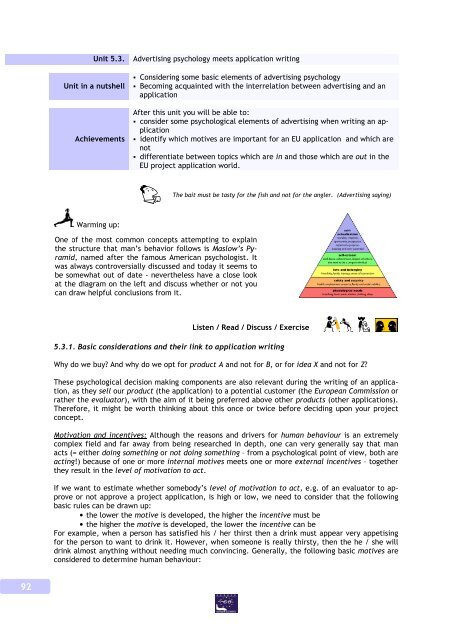We All are Europe - AESAEC
We All are Europe - AESAEC
We All are Europe - AESAEC
Create successful ePaper yourself
Turn your PDF publications into a flip-book with our unique Google optimized e-Paper software.
Unit 5.3.<br />
Unit in a nutshell<br />
Achievements<br />
Advertising psychology meets application writing<br />
Considering some basic elements of advertising psychology<br />
Becoming acquainted with the interrelation between advertising and an<br />
application<br />
After this unit you will be able to:<br />
consider some psychological elements of advertising when writing an application<br />
identify which motives <strong>are</strong> important for an EU application and which <strong>are</strong><br />
not<br />
differentiate between topics which <strong>are</strong> in and those which <strong>are</strong> out in the<br />
EU project application world.<br />
The bait must be tasty for the fish and not for the angler. (Advertising saying)<br />
Warming up:<br />
One of the most common concepts attempting to explain<br />
the structure that man’s behavior follows is Maslow’s Pyramid,<br />
named after the famous American psychologist. It<br />
was always controversially discussed and today it seems to<br />
be somewhat out of date - nevertheless have a close look<br />
at the diagram on the left and discuss whether or not you<br />
can draw helpful conclusions from it.<br />
Listen / Read / Discuss / Exercise<br />
5.3.1. Basic considerations and their link to application writing<br />
Why do we buy And why do we opt for product A and not for B, or for idea X and not for Z<br />
These psychological decision making components <strong>are</strong> also relevant during the writing of an application,<br />
as they sell our product (the application) to a potential customer (the <strong>Europe</strong>an Commission or<br />
rather the evaluator), with the aim of it being preferred above other products (other applications).<br />
Therefore, it might be worth thinking about this once or twice before deciding upon your project<br />
concept.<br />
Motivation and incentives: Although the reasons and drivers for human behaviour is an extremely<br />
complex field and far away from being researched in depth, one can very generally say that man<br />
acts (= either doing something or not doing something – from a psychological point of view, both <strong>are</strong><br />
acting!) because of one or more internal motives meets one or more external incentives – together<br />
they result in the level of motivation to act.<br />
If we want to estimate whether somebody’s level of motivation to act, e.g. of an evaluator to approve<br />
or not approve a project application, is high or low, we need to consider that the following<br />
basic rules can be drawn up:<br />
• the lower the motive is developed, the higher the incentive must be<br />
• the higher the motive is developed, the lower the incentive can be<br />
For example, when a person has satisfied his / her thirst then a drink must appear very appetising<br />
for the person to want to drink it. However, when someone is really thirsty, then the he / she will<br />
drink almost anything without needing much convincing. Generally, the following basic motives <strong>are</strong><br />
considered to determine human behaviour:<br />
92









